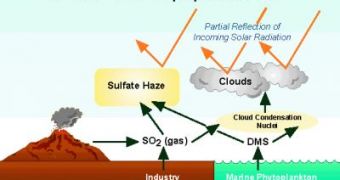Injecting sulfur into the atmosphere to slow down global warming is worthy of serious consideration, according to Nobel laureate Paul Crutzen from the Max Planck Institute for Chemistry in Germany and the Scripps Institution of Oceanography, University of California at San Diego. His thought-provoking paper is published in the August issue of the Springer journal Climatic Change, devoted this month to the controversial field of geoengineering.
Fossil fuel burning releases carbon dioxide into the atmosphere, which contributes significantly to global warming. Burning of fossil fuel also releases sulfur into the earth's atmosphere, in the form of sulfate particles. Ironically, these sulfate particles help to cool down the planet by reflecting solar radiation back into space. Crutzen's proposed planet-saving scheme, which artificially injects sulfur into the earth's stratosphere (the second atmospheric layer closest to earth) to offset greenhouse gas warming, is based on this phenomenon.
His "albedo enhancement method", or, in other words, his proposed way of increasing the earth's reflective powers so that a more significant proportion of solar radiation is reflected back into space, aims to replicate the cooling effect these man-made sulfate particles achieve.
This phenomenon is also observed during volcanic eruptions. Crutzen uses the Mount Pinatubo eruption in 1991as a model for his idea. The volcanic eruption injected sulfur into the stratosphere. The enhanced reflection of solar radiation to space by the particles cooled the earth's surface by an average of 0.5 degrees Celsius (0.9 degrees Fahrenheit) in the year following the eruption.
In Crutzen's experiment, artificially enhancing earth's reflective powers would be achieved by carrying sulfur into the stratosphere on balloons, using artillery guns to release it. In contrast to the slowly developing effects of global warming associated with man-made carbon dioxide emissions, the climatic response of the albedo enhancement method could theoretically start taking effect within six months. The reflective particles could remain in the stratosphere for up to two years.
"Given the grossly disappointing international political response to the required greenhouse gas emissions,?research on the feasibility and environmental consequences of climate engineering of the kind presented in this paper, which might need to be deployed in future, should not be tabooed," says Crutzen. He adds that his experiment should only be used as an emergency measure: "the possibility of the albedo enhancement scheme should not be used to justify inadequate climate policies but merely to create a possibility to combat potentially drastic climate heating."

 14 DAY TRIAL //
14 DAY TRIAL // 
